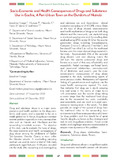| dc.contributor.author | Nyaga, Josephine | |
| dc.contributor.author | Mwaura, P | |
| dc.contributor.author | Mutundu, K | |
| dc.contributor.author | Njeru, D | |
| dc.contributor.author | Juma, G | |
| dc.contributor.author | Were, T | |
| dc.date.accessioned | 2024-01-12T15:05:38Z | |
| dc.date.available | 2024-01-12T15:05:38Z | |
| dc.date.issued | 2021-12-31 | |
| dc.identifier.uri | https://www.nacada.go.ke/sites/default/files/2022-03/Socio-Economic%20and%20Health%20Consequences%20of%20Drugs%20and%20Substance%20Use%20in%20Gachie%2CPeri-Urban%20Town%20On%20the%20Outskirts%20of%20Nairobi.pdf | |
| dc.identifier.uri | http://ir-library.mmust.ac.ke:8080/xmlui/handle/123456789/2545 | |
| dc.description.abstract | Drug and substance abuse is a major socioeconomic and health problem to the drug users,
family and society and is reported to be on a
steady global rise. In Kenya, drug abuse is a major
societal problem especially in many cosmopolitan
cities such as Nairobi and Mombasa and the
surrounding immediate environs. The objective
of this study was to evaluate the types of drugs,
the socio-economic and health consequences of
drug abuse among the inhabitants of Gachie
Sub-Location, Kiambu County a town within
the Nairobi suburbs. A snowballing sampling
method was used to recruit a total of 246 study
participants aged between 15-65years recruited
into the study after consenting and meeting drug
and substance use and dependence clinical
evaluation according to UNCOPE criteria. Data
on the type of drugs abused, socio-economic
and health implications of drug use on both drug
abusers and the community was captured using
a structured questionnaire and the resulting data
analysed using SPSS version 21. Over-the counter
prescription drugs including, benzodiazepine,
Cozepam (“ma-cc”), rohypnol (“ma-blue”), and
benzhexol (“ma-white”) as well as the traditional
heroine were the major abused drugs reported in
the study. Approximately 85% of the sampled
drug abusers were men abusing mainly the
licit over- the counter prescription drugs and
heroine as a result of their easy affordability and
accessibility. Failed marriages, conflictual family
and communal relationships, unemployment,
life of destitution and poverty were the main
socioeconomic consequences of drug abuse
reported in the study, corroborating reports of
some previous studies. Participants’s self-reported
feeling of hyperactiveness and euphoria was the
major health consequence repoted. This study
thus indicates that drug use is slowly creeping
into rural areas in the vicinity of major towns
with prescription over the counter drugs taking
a centre stage than the traditional hard drugs
due to the associated low costs, availability
and accessibility and can result in myriad socioeconomic consequences in the society. This data
provides an insight of the spread of drugs from
the traditional cities to the surrounding town
environments as these areas provide a safe haven
for drug peddlers and thus should be of great
focus by drug law enforcers as they strategize and
seek to curb drug abuse problem. Future similar
studies involving larger area are recommended to
acquire more dynamics of this problem | en_US |
| dc.language.iso | en | en_US |
| dc.publisher | African Journal of Alcohol & Drug Abuse | en_US |
| dc.subject | Socio-Economic, Health, Consequences, Drugs, Substance, Use, Gachie, A Peri-Urban ,Town | en_US |
| dc.title | Socio-Economic and Health Consequences of Drugs and Substance Use in Gachie, A Peri-Urban Town on the Outskirts of Nairobi | en_US |
| dc.type | Article | en_US |

